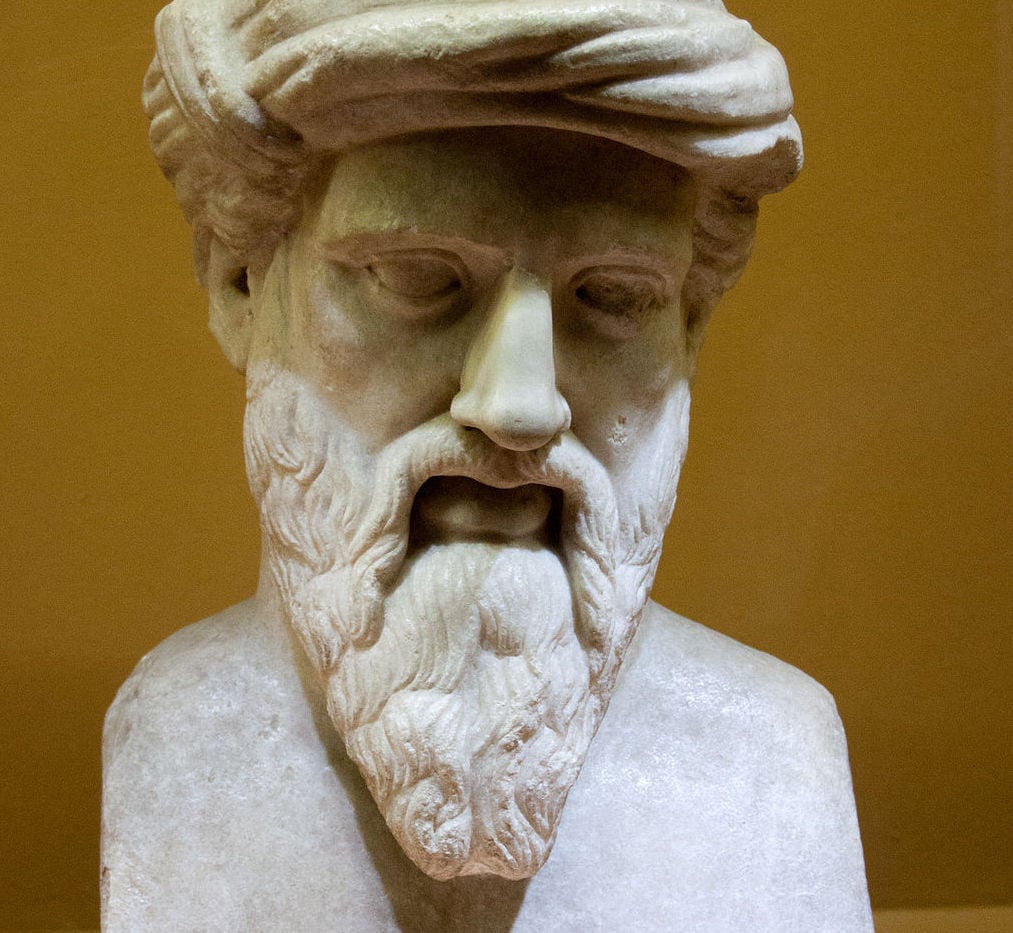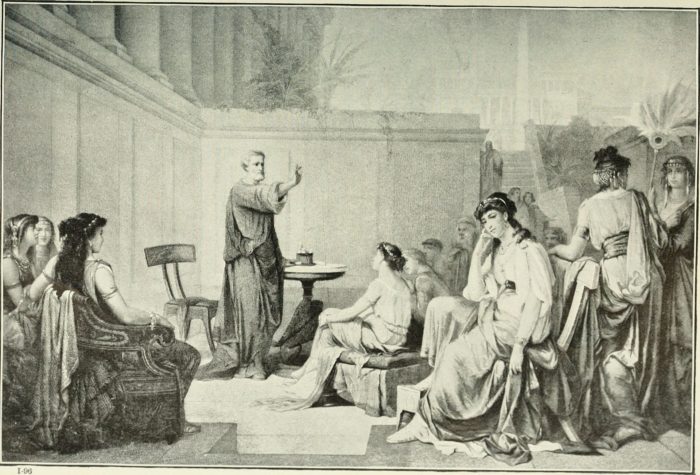
The influence of Pythagoras in mathematics and philosophy remains strong today, as do the mysteries surrounding the great Greek philosopher.
Like philosophy and religion, the science of mathematics can change the way we perceive the world and has a massive impact on our lives.
Pythagoras’ philosophy influenced both Plato and Aristotle, and through them his ideas were fundamental in Western philosophy.
In his life 2,500 years ago, the Greek philosopher combined philosophy, mathematics, and religion, and his work and ideas are still influential to this day.
The Pythagorean theorem remains fundamental in mathematics, and is taught in schools across the world.
Pythagoras’ life
The Greek philosopher and mathematician was born on Samos to an aristocratic family in 570 BC. He came from the house of Agaios, who was the founder of the colony of Samos.
His father, Mnesarchus was a precious stones engraver. However, his early life is clouded by mystery, with modern scholars disagreeing about his education and influences.
It is said that Pythagoras was of exceptional beauty and many considered him to be the son of Apollo, who was patron god of philosophers, among others.
It is also said that he took his name from the fact that the priestess of Pythian Apollo had predicted his birth (before it even became known that his mother was pregnant) on a trip made by his father to Delphi.
For the same reason, his mother was renamed Pythaida from Parthenida, which was her original name.
According to the oracle at Delphi, Pythagoras would tell the truth in his life. The Pythian oracle also proclaimed that he would benefit humanity.
According to ancient texts, Pythagoras had a golden thigh and many believed he was a divine demon. To ancient Greeks, the word demon did not have the same meaning as it has to Christians. A demon was a divine entity mediating between gods and humans.
Around 530 BC the Greek philosopher traveled to Croton (today’s Crotone) in southern Italy and founded a school. The Pythagoras’ schools initiates were sworn to secrecy and lived a communal, ascetic life.
This lifestyle entailed a number of dietary prohibitions, said to include vegetarianism, although some modern scholars doubt that he advocated for the diet.
Pythagoras’ mysterious personality was noticeable during his teaching. Strangely, no notes and questions were allowed in his lessons, which is why a great part of his works are lost. There is no additional information even on the renowned Pythagorean theorem.
It is also not known if Pythagoras invented this theorem on his own or with the help of his students.
At an old age, Pythagoras married one of his students in Croton, Theano, and had children with her. Again, there is disagreement among scholars over the number and the names of the children.
He died around 495 BC in Metapontum, Lower Italy, starving himself for 40 days because of his grief over the persecution of the Pythagoreans and the killing of the majority of them.
Another ancient account states that Pythagoras was killed for political reasons, as followers of his opponents Cylon and Ninon attacked the Pythagoreans during a house meeting.
After his death, Greek philosopher’s house was made into a sanctuary of Demeter, and the road that led to it became a sanctuary of the Muses.

The Pythagorean school
Pythagoras traveled across Greece to study under great philosophers of his time. He could even be described as one of the most widely traveled ancient philosophers.
Pythagoras was a student of Ferekidis, while he was in Lesvos, and of Aneximander and Thales when he went to Miletus.
The Greek philosopher visited many of the countries of the known world at the time on a religious and scientific quest for “Absolute Knowledge.”
He was initiated in all the sanctuaries through which he passed and always became loved and respected by the priests. Among the areas he visited were Egypt, Persia, Syria, Sparta and Crete.
It is said that he took most of the moral doctrines from Themistocleia, who was a priestess of Delphi. He was greatly influenced by the Ionian philosophers (especially in the study of nature and the universe), as well as by the occultism of Orphism.
Pythagoras also studied geometry (literally meaning “measuring the earth” in Greek) and perfected it.
Southern Italy and Sicily were named Greater Greece (Magna Graecia) thanks to Pythagoras who gathered philosophers, scientists and virtuous people in the region.
The huge house in which he taught in Croton was called Oimakoion. In this organization property and knowledge were considered common. Any discovery was not attributed to a specific member but to all.
The Pythagorean School had a very conservative and strict code of conduct. The students had to keep the teachings and theories secret and if that did not happen it could even cost them their lives, it is said.
Pythagoras had female students
Unlike in philosophical schools of the time, many of Pythagoras’ students were women.
It is said that at the entrance of the school the Pythagoreans had engraved the saying “ΜΗΔΕΙΣ ΑΓΕΩΜΕΤΡΗΤΟΣ ΕΙΔΙΣΙΤΩ”, which meant that no person who does not measure things by earthly measures should enter.
The three basic criteria for Pythagoras to accept someone in his school were wisdom, justice and bravery. He imposed a strict examination on those young people who asked him to become members of the school.
He interrogated them to learn how they treated their parents and friends, and even observed them in every detail, including their demeanor, their gait, their unnecessary speech, their silence, and even the way they laughed.
Pythagoras is considered to have coined the words “philosophy” (love of wisdom) and “mathematics” (what is learned), trying to describe the spiritual nature of his school.
He is said to have given two kinds of lectures: one exclusively for the members of the school and one for all the others.
Pythagoras and his school played a most crucial role in the history of mathematics. They put a new emphasis on mathematics, recognizing its association more with the love of wisdom than with the demands of life as it was at the time.
The Pythagorean school was pivotal in the evolution of human intellect and in raising the level of philosophical thought for 2,500 years.
According to Pythagoras’ strict rules, all members avoided eating meat. This was because they believed in the transmigration of life, and therefore the slaughter of an animal was considered the destruction of the new home of a person (friend) who had died.
For Pythagoras, neither wealth nor origin was a criterion for membership, and for this reason he never allowed Cylon, who was wealthy and from an aristocratic family, to be a student in the Pythagorean school. He considered that Cylon’s upbringing hadn’t produced a noble character – instead he was violent and difficult, and behaved like a tyrant.
Cylon was infuriated at Pythagoras for expelling him, and used his wealth and position to turn people against the philosopher and mathematician.
Together with his supporters, Cylon attacked the Pythagoreans and burned their house down.

The Pythagorean Theorem
“Everything is a number” was the motto of the Pythagorean School. Pythagoras was influenced by the Babylonians, so the theorem attributed to his name probably came from them.
The Babylonians assigned numerical values to everything around them, from the movement of the planets to the efficiency of their slaves. That is why their theories are connected with those of Pythagoras.
There is a myth that Pythagoras sacrificed a calf, or a hundred calves according to other versions, to prove his theorem. However, this does not comply with the school’s dietary rules, so it is considered almost impossible.
“Ἐν τοῖς ὀρθογωνίοις τριγώνοις τὸ ἀπὸ τῆς τὴν ὀρθὴν γωνίαν ὑποτεινούσης πλευρᾶς τετράγωνον ἴσον ἐστὶ τοῖς ἀπὸ τῶν τὴν ὀρθὴν γωνίαν περιεχουσῶν πλευρῶν τετραγώνοις.”
That is, in a right triangle, the square of the hypotenuse is equal to the sum of the squares of the two perpendicular sides.
The Pythagorean is perhaps the best known of the mathematical theorems. It is a theorem that most people claim to know even if they don’t understand what it means.
The Pythagorean Theorem was known long before Pythagoras. It was formulated earlier, but only as an empirical, unproven observation.
Mathematicians from Babylon, China, Mesopotamia, India knew that the relationship described by the Pythagorean Theorem was valid, but Pythagoras was the first person to prove it.
The simple phrase “The square of the hypotenuse (the side opposite the right angle) is equal to the sum of the squares of the other two sides” is pure mathematical magic.
For this reason the theorem got its name. It was later proven by many mathematicians, both geometrically and algebraically.
The Greek philosopher’s theorem remains current 2,500 years later because it is a simple relation of square numbers inside of which all the glamor of mathematical science is hidden.
The Pythagorean theorem is justifiably the most popular and at the same time the most majestic theorem of mathematical science.
Other than his famous theorem, Pythagoras was credited with many mathematical and scientific discoveries, including Pythagorean tuning, the five regular solids, and the Theory of Proportions.
Also, Pythagoras made developments regarding the spherical nature of the Earth and identified the morning and evening stars as the planet Venus.
It was said that he was the first man to call himself a philosopher and that he was the first to divide the globe into five climatic zones.
The Pythagorean theorem is everywhere
There are several reasons to love the theorem that changed the history of mathematics. It would be impossible to try to describe in detail the effects that the genius idea of Pythagoras had on the later history of mathematics.
Number Theory, the later “Diophantine Equations” and the study of prime numbers in general have the Pythagorean theorem as their basis.
The more than 370 different proofs of the Greek philosopher Pythagoras’ theorem show in the most obvious way the huge scientific spectrum contained in a simple right triangle.
Geometry, trigonometry, algebra, differential equations and even imaginary complex numbers were founded using the Pythagorean theorem.
See all the latest news from Greece and the world at Greekreporter.com. Contact our newsroom to report an update or send your story, photos and videos. Follow GR on Google News and subscribe here to our daily email!



